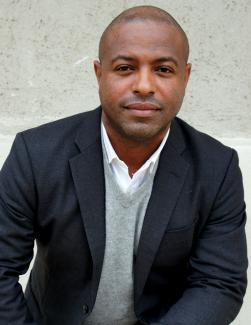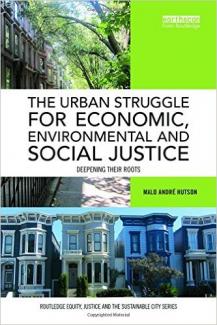Could you talk a bit about how you ended up where you are today?
I became a professor in a sort of roundabout way. I have always been interested in poverty and inequality. As an undergraduate at Berkeley, I did research around these issues in Oakland. This was around the time when the Dotcom Boom took off and I remember my Economics professor saying that anyone who wants a job can get a job. But that wasn’t what I saw in these communities in Oakland, where largely African American and Latino males didn’t have any employment opportunities. From there I became interested in the broader, macro factors that shape our economy that lead to economic opportunities, which also affect health and well-being.
Your new book, The Urban Struggle for Economic, Environmental, and Social Justice: Deepening Their Roots, was recently published. What is it about?
The book looks at neighborhood change and displacement in a number of cities. I conducted a case study analysis on San Francisco, Boston, New York, and Washington, DC, examining how housing prices are going up, development pressures are rising, and what impact that is happening on traditional working class or less affluent communities. These are largely communities of color where residents are organizing, forming coalitions to protest this change. I follow what’s happening at both the policy level and at the grassroots level.
In addition to your work locally, you’ve also worked internationally, most recently in Chile.
This summer I took a group of students to a city in Chile called Talca that was hit hard by the 8.8 earthquake in 2010. Many residents have been displaced outside of the city. Investment back into the city has been uneven, so I’ve been working with my colleagues at the Catholic University in Chile to set up a development fund and plan for Talca. I’ve also recently been having conversations with the federal government, with the Administration of Housing and Urban Development, to do two things: Firstly, to renovate public housing, focusing on bringing mixed income residents together and creating social cohesion, and secondly to develop integrated sustainable communities, integrating green space, housing, transportation, and addressing issues related to climate change.
Much of your research has been about health and public health. Could you talk a bit about structures related to public health?
Lets look at major disparities in Oakland, for example. Anthony Iton, the former director and County Health Officer for the Alameda County Public Health Department used to talk about the flatland vs. the hills, illustrating that if you lived in the flatlands, your life expectancy was seven years shorter than those who lived in the hills. The factors that lead to those outcomes include things like access to good quality air, not having diesel trucks, freeways, the port — all of these things are contributing to poorer air pollution quality. There is a lack of access to healthy food or lack of investment in the area, which can lead to all sorts of negative outcomes like people hanging out where they shouldn’t and being exposed to violence.
But really what it boils down to is lack of opportunity. Factors that matter for having a healthy life include things like access to education, areas to walk in and be safe, parks and open space, having access to healthy water, and access to neighbors with which you can build social networks. We see this inequality play out across the region, and much of that has to do with the ways our cities are structured. So when you think about health disparities or health inequalities, much of it has to do with the built environment, which doesn’t just exist by itself, it is created by institutions, policies, and decision-makers.
A lot of discussion right now is centered on the rapid gentrification of the Bay Area. What is your take on that and what can be done to mitigate some of the challenges that come with these changes?
We have to first look at what might be some of the larger macro causes. One cause might be global capital. We did not predict that after the Great Recession of 2008/2009, global
capital would have reorganized itself and say, “Hey, cities are a great place to invest in, we can start buying up a lot of these foreclosed properties and create a generation of renters.” We’ve seen this in a lot of cities, especially in West Oakland, where a lot of houses were bought up and are now being rented out.But then you also have a set of policies that focus on transit-oriented development, reducing greenhouse gas emissions, like in California, which is a good idea, but that means there’s no money for affordable housing. So if cities start spending money on transit, we’re finding that much of this spending is going to people who already have money and access to good quality jobs, not those who need affordable housing.
The third factor in this change is the Bay Area’s economy — which is seeing a large growth in knowledge-based industries, like research and development, medical and health, etc. A lot of advanced manufacturing here is being outsourced. This means that the jobs that are available are either on the high end, paying very well, or they are service sector jobs to support those high-end jobs. So that’s a problem. Where this is happening, in places like San Francisco or Boston, cost of living goes up and the poor are moving further and further away. Once you start to be on the outskirts, your political power goes down, your ability even just to protest, to have a voice is greatly limited and that’s what I see happening.
So what can be done?
What do we do about it? One is that we have to build way more housing than we’re doing and we have to think about this in an equitable way. Equitable economic development — we can’t just rely on the market. Cities and governments need to set policies that require different types of affordable housing to be built. They can create incentives, they can do quite a bit.






